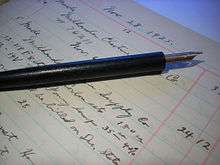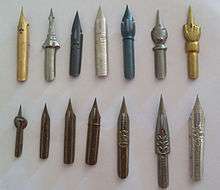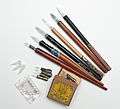Dip pen


A dip pen or nib pen usually consists of a metal nib with capillary channels like those of fountain-pen nibs, mounted in a handle or holder, often made of wood. Other materials can be used for the holder, including bone, metal, and plastic; some pens are made entirely of glass. Generally, dip pens have no ink reservoir, so the user must recharge the ink from an ink bowl or bottle to continue drawing or writing. There are simple, tiny tubular reservoirs that illustrators sometimes clip onto dip pens, which allow drawing for several minutes without recharging the nib. Recharging can be done by dipping into an inkwell; but some illustrators and cartoonists, who are the main users of such pens, are likelier to charge the pen with an eyedropper, a syringe, or a brush, which gives more control over the amount of ink applied. Thus, "dip pens" are not necessarily dipped; many illustrators call them "nib pens".
Dip pens emerged in the early 19th century, when they replaced quill pens and, in some parts of the world, reed pens. Dip pens were generally used before the development of fountain pens in the later 19th century, and are now mainly used in illustration, calligraphy, and comics.
The dip pen has certain advantages over a fountain pen. It can use waterproof, pigmented, particle-and-binder-based inks, such as India ink, drawing ink, and acrylic inks—each of which would destroy a fountain pen by clogging it—and the traditional iron gall ink, which can corrode fountain pens. Dip pens are also more sensitive to variations of pressure and speed, producing a line that naturally varies in thickness; and they can also produce a finer line than any fountain pen.
There is a wide range of exchangeable nibs for dip pens, so different types of lines and effects can be created. The nibs and handles are far cheaper than most fountain pens, and allow color changes much more easily.
History
The earliest known split-nib metal dip pen is a surviving copper-alloy pen found in Roman Britain (AD 43 to 410).[1] There have been several other surviving all-metal and removable-nib pens from the Middle Ages and Renaissance that have been found, suggesting they were used alongside quill pens.[2][3][4][5]
.jpg)

The steel pen is first attested in Daniel Defoe's book "A Tour Through the Whole Island of Great Britain – 1724–26". In Letter VII Defoe wrote: "the plaster of the ceilings and walls in some rooms is so fine, so firm, so entire, that they break it off in large flakes, and it will bear writing on it with a pencil or steel pen." In Newhall Street, John Mitchell pioneered mass production of steel pens in 1822; prior to that the quill pen had been the most common form of writing instrument. His brother William Mitchell later set up his own pen making business in St Paul's square. The Mitchell family is credited as being the first manufacturers to use machines to cut pen nibs, which greatly sped up the process.
The Jewellery Quarter and surrounding area of Birmingham, England was home to many of the first dip pen manufacturers, which some companies establishing there to produce pens. Some of those companies were Joseph Gillott's (established in 1827), Sir Josiah Mason (1827), Hink Wells & Co. (1836), Baker and Finnemore (1850), C. Brandauer & Co. (1850), D. Leonardt & Co. (1856).[6]
Baker and Finnemore operated in James Street, near St Paul's Square. C Brandauer & Co Ltd., founded as Ash & Petit, traded at 70 Navigation Street. Joseph Gillott & Sons Ltd. made pen nibs in Bread Street, now Cornwall Street. Hinks Wells & Co. traded in Buckingham Street, Geo W Hughes traded in St Paul's Square, D. Leonardt & Co./Leonardt & Catwinkle traded in George Street and Charlotte Street, and M Myers & Son. were based at 8 Newhall Street. By 1830 John and William Mitchell, Joseph Gillott, and Josiah Mason were the major manufacturers in Birmingham.
In Germany the industrial production of dip pens started in 1842 at the factory of Heintze & Blanckertz in Berlin.
By the 1850s, Birmingham existed as a world centre for steel pen and steel nib manufacture. More than half the steel nib pens manufactured in the world were Birmingham-made. Thousands of skilled craftsmen and women were employed in the industry. Many new manufacturing techniques were perfected in Birmingham, enabling the city's factories to mass-produce their pens cheaply and efficiently. These were sold worldwide to many who previously could not afford to write, which encouraged the development of education and literacy. By 1860 there were about 100 companies making steel nibs in Birmingham, but 12 large firms dominated the trade. In 1870 Mason, Sommerville, Wiley, and Perry, merged to form Perry & Co. Ltd. which later became one of the largest manufacturers in the world, with near 2,000 employees.[7]

Richard Esterbrook manufactured quill pens in Cornwall. In the 19th century, he saw a gap in the American market for steel nib pens. Esterbrook approached five craftsmen who worked for John Mitchell in Navigation Street with a view to setting up business in Camden, New Jersey, US. Esterbrook founded his company in 1858, and it grew to become one of the largest steel pen manufacturers in the world. In 1971 it went out of business.
The oblique dip pen was designed for writing the pointed pen styles of the mid 19th to the early 20th century such as Spencerian Script, although oblique pen holders can be used for earlier styles of pointed penmanship such as the copperplate scripts of the 18th and 19th centuries. As the name suggests, the nib holder holds the nib at an oblique angle of around 55° pointing to the right hand side of the penman. This feature helps greatly in achieving the steep angle required for writing certain scripts, but more importantly, it prevents the right hand nib tine from dragging on the paper as can be experienced when using a straight nib holder with a straight nib for this purpose.
The decreasing production of dip pens and the subsequent demise of the industry in Birmingham is often blamed on the invention of the ballpoint pen in 1938 by the Hungarian Laszlo Biro.[8][9]
One improved version of the dip pen, known as the original "ballpoint", was the addition of a curved point (instead of a sharp point) which allows the user to have slightly more control on upward and sideways strokes. This feature, however, produces a thicker line rather than the razor-sharp line produced by a sharp point.
Pen makers
Some of the more prominent dip pen manufacturers (in past and present time) are:[6]
| Country | Manufacturers (Brands) |
|---|---|
| Austria | Carl Kuhn, Salcher, Hiro |
| Czechoslovakia | Massag |
| England | C. Brandauer & Co., Joseph Gillott's, Baker & Finnemore, Ormiston and Glass, Perry & Co., Josiah Mason, Hinks Wells & Co., Geo W. Hughes, John Mitchell, William Mitchell, J. Cooke & Sons, M. Myers & Son, D. Leonardt & Co. |
| France | Baignol et Farjon, Blanzy-Poure, Cie. Francaise, Plumes Parisiennes, J.B. Mallat |
| Germany | Brause, F. Soennecken, Heintze & Blanckertz, Herm. Müller, Leo's, Pelikan |
| Japan | Nikko, Tachikawa, Zebra |
| Spain | A. Fabre, Boira, Cervantinas, Campoamor, Daimar, Goya, Imsa, Jaer, Verabil |
| Scotland | MacNiven & Cameron |
| United States | Esterbrook, C. Howard Hunt, Turner & Harrison, Speedball, Eagle Pencil Co., E. S. Hollyson & Co., Leroy W. Fairchild, Aikin Lambert |
| South Korea | Whashin |
Uses
Dip pens are rarely used now for regular writing, most commonly having been replaced by fountain pens, rollerball pens, or ballpoint pens. However, dip pens are still appreciated by artists, as they can make great differences between thick and thin lines, and generally write more smoothly than other types of pens. Dip pens are also preferred by calligraphers for fine writing.
Although most of the factories ceased manufacturing dip pens,[6] some companies are still active, such as Speedball, Brause (currently owned by American company Exaclair, Inc.),[10][11] D. Leonardt & Co., William Mitchell and Joseph Gillott's.
Gallery
 Various pen nibs and their penholders.
Various pen nibs and their penholders. Brause "Christian IX" pen (with portrait carved) and its penholder
Brause "Christian IX" pen (with portrait carved) and its penholder A rare nib with the body shaped as the Eiffel Tower.
A rare nib with the body shaped as the Eiffel Tower. Sand-McDougall carved nib.
Sand-McDougall carved nib. An old Soennecken pens catalog.
An old Soennecken pens catalog. Various Perry models.
Various Perry models. Glass dip pens.
Glass dip pens.
See also
References
- ↑ "Pen, split nib - Romano-British period". British Museum. Retrieved 2016-12-04.
- ↑ "Pen- Museum of London". collections.museumoflondon.org.uk. Retrieved 2016-12-04.
- ↑ "Pen - Museum of London". collections.museumoflondon.org.uk. Retrieved 2016-12-04.
- ↑ Dr. Adam Daubney (1600). "Record ID: LIN-CDD296 - POST MEDIEVAL pen". The Portable Antiquities Scheme. Retrieved 2016-12-04.
- ↑ Veliki Preslav (2012-09-29). "Bulgarian archaeologists find unique set of pen nibs used in the Golden Age -". FOCUS Information Agency. Retrieved 2016-12-04.
We found an incredibly interesting and one of its kind set of 11 bronze pen nibs, which used to be put on the pens during the Golden Age of Simeon I of Bulgaria
- 1 2 3 More about the pen trade at the Wayback Machine (archived March 13, 2012)
- ↑ "Perry and Co". gracesguide.co.uk.
- ↑ "Pen makers: William Mitchell and Joseph Gillott", Birmingham Mail, 3 Nov 2014
- ↑ "A Brief History of Writing Instruments, Part 3: The Battle of the Ballpoint Pens" by Mary Bellis on About.com
- ↑ "Brause brand". exaclair.com. Retrieved 7 July 2015.
- ↑ "Brause". cultpens.com.
External links
| Wikimedia Commons has media related to Dip pens. |
- Kallipos, Calligraphy German website
- Manuscript Pen Company
- Scribblers, calligraphy website
- Blam! Design, calligraphy and vintage pens
- The Pen Museum at Birmingham Heritage forum
- Birmingham Pen Room, writing and pen museum (Archive)